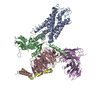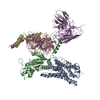+Search query
-Structure paper
| Title | Structural insights into the activation of somatostatin receptor 2 by cyclic SST analogues. |
|---|---|
| Journal, issue, pages | Cell Discov, Vol. 8, Issue 1, Page 47, Year 2022 |
| Publish date | May 20, 2022 |
 Authors Authors | Qing Bo / Fan Yang / Yingge Li / Xianyu Meng / Huanhuan Zhang / Yingxin Zhou / Shenglong Ling / Demeng Sun / Pei Lv / Lei Liu / Pan Shi / Changlin Tian /  |
| PubMed Abstract | The endogenous cyclic tetradecapeptide SST14 was reported to stimulate all five somatostatin receptors (SSTR1-5) for hormone release, neurotransmission, cell growth arrest and cancer suppression. Two ...The endogenous cyclic tetradecapeptide SST14 was reported to stimulate all five somatostatin receptors (SSTR1-5) for hormone release, neurotransmission, cell growth arrest and cancer suppression. Two SST14-derived short cyclic SST analogues (lanreotide or octreotide) with improved stability and longer lifetime were developed as drugs to preferentially activate SSTR2 and treat acromegalia and neuroendocrine tumors. Here, cryo-EM structures of the human SSTR2-Gi complex bound with SST14, octreotide or lanreotide were determined at resolutions of 2.85 Å, 2.97 Å, and 2.87 Å, respectively. Structural and functional analysis revealed that interactions between β-turn residues in SST analogues and transmembrane SSTR2 residues in the ligand-binding pocket are crucial for receptor binding and functional stimulation of the two SST14-derived cyclic octapeptides. Additionally, Q102, N276, and F294 could be responsible for the selectivity of lanreotide or octreotide for SSTR2 over SSTR1 or SSTR4. These results provide valuable insights into further rational development of SST analogue drugs targeting SSTR2. |
 External links External links |  Cell Discov / Cell Discov /  PubMed:35595746 / PubMed:35595746 /  PubMed Central PubMed Central |
| Methods | EM (single particle) |
| Resolution | 2.85 - 2.97 Å |
| Structure data | EMDB-33098, PDB-7xat: EMDB-33099, PDB-7xau: EMDB-33100, PDB-7xav: |
| Source |
|
 Keywords Keywords | MEMBRANE PROTEIN / G protein coupled receptor / Cryo-EM / SST analogues / Polypeptide drugs |
 Movie
Movie Controller
Controller Structure viewers
Structure viewers About Yorodumi Papers
About Yorodumi Papers









 homo sapiens (human)
homo sapiens (human)
